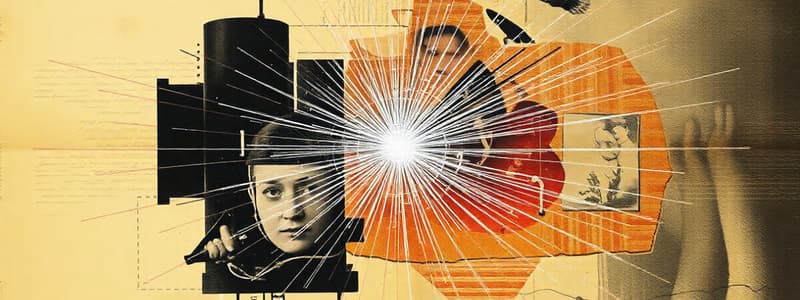Podcast
Questions and Answers
What happens to the electric field strength when the distance between two point charges is doubled?
What happens to the electric field strength when the distance between two point charges is doubled?
- It remains constant.
- It decreases by a factor of four. (correct)
- It increases by a factor of four.
- It doubles.
Which statement accurately reflects the concept of electric potential?
Which statement accurately reflects the concept of electric potential?
- Electric potential is directly proportional to electric field strength.
- Electric potential is the force acting on a charge in an electric field.
- Electric potential is the work done per unit charge to move a charge from a reference point. (correct)
- Electric potential is the total energy stored in a capacitor.
When connected in series, how does the total resistance of a circuit change?
When connected in series, how does the total resistance of a circuit change?
- It is equal to the average of individual resistances.
- It decreases.
- It remains unchanged.
- It increases proportionally to the number of resistors. (correct)
What is the relationship described by Ohm's Law?
What is the relationship described by Ohm's Law?
How does a conductor behave compared to an insulator when placed in an electric field?
How does a conductor behave compared to an insulator when placed in an electric field?
What is the role of a capacitor in an electric circuit?
What is the role of a capacitor in an electric circuit?
If two point charges are equal and of the same sign, how will they interact according to Coulomb’s Law?
If two point charges are equal and of the same sign, how will they interact according to Coulomb’s Law?
How is energy stored in a capacitor calculated?
How is energy stored in a capacitor calculated?
In a parallel circuit, how is the total resistance calculated?
In a parallel circuit, how is the total resistance calculated?
Flashcards
Electrostatics
Electrostatics
The study of stationary electric charges and the forces they exert on each other.
Quantization of Charge
Quantization of Charge
Electric charges exist in discrete units, multiples of the elementary charge (e).
Attraction/Repulsion of Charges
Attraction/Repulsion of Charges
Like charges repel each other, while unlike charges attract.
Coulomb's Law
Coulomb's Law
Signup and view all the flashcards
Electric Field
Electric Field
Signup and view all the flashcards
Conductors
Conductors
Signup and view all the flashcards
Insulators
Insulators
Signup and view all the flashcards
Electric Potential
Electric Potential
Signup and view all the flashcards
Potential Difference (Voltage)
Potential Difference (Voltage)
Signup and view all the flashcards
Capacitance
Capacitance
Signup and view all the flashcards
Study Notes
Electrostatics
- Electrostatics deals with stationary electric charges and the forces they exert on each other.
- Electric charges are quantized, meaning they exist in discrete units, like multiples of the elementary charge (e).
- Like charges repel each other, while unlike charges attract.
- Coulomb's Law describes the force between two point charges: Force = k * |q1 * q2| / r^2, where k is Coulomb's constant, q1 and q2 are the charges, and r is the distance between them.
- Electric fields are a way to visualize the influence of a charge on the surrounding space. The field strength at a point is the force per unit positive charge.
- Electric field lines originate from positive charges and terminate on negative charges, indicating the direction of the force on a positive test charge.
- Conductors allow free movement of electrons, distributing charges evenly on their surface.
- Insulators prevent electron flow—charges remain localized.
- Electric potential is the work done per unit charge to move a charge from infinity to a specific point in an electric field. It's measured in volts (V).
- Potential difference or voltage is the difference in electric potential between two points.
- Capacitance is the ability of a system to store electric charge. It is measured in Farads (F). A capacitor is a device used to store electric charge.
- Capacitors store energy in the form of electric fields, and the energy stored is equal to 1/2 * C * V^2.
Current Electricity
- Current electricity deals with the flow of electric charge.
- Electric current (I) is the rate of flow of charge, measured in amperes (A). I = Q/t, where Q is charge and t is time.
- Current flows from higher potential to lower potential.
- Ohm's Law states that the current through a conductor between two points is directly proportional to the voltage across the two points. Ohm's Law is: V = I * R, where V is voltage, I is current, and R is resistance.
- Resistance (R) is a measure of a material's opposition to current flow; it's measured in ohms (Ω).
- Conductors have low resistance; insulators have high resistance.
- Resistors are used in circuits to control current flow.
- Series circuits have components connected end-to-end. Total resistance adds up in series: Rtotal = R1 + R2 + ...
- Parallel circuits have components connected across each other. The reciprocal of total resistance is the sum of the reciprocals of the individual resistances: 1/Rtotal = 1/R1 + 1/R2 + ...
- Kirchhoff's Current Law: the total current entering a junction equals the total current leaving it.
- Kirchhoff's Voltage Law: the sum of voltage drops around any closed loop in a circuit must equal zero.
- Power dissipated in a resistor is given by P = I2R = V2/R = IV.
- A battery is a source that provides a potential difference in a circuit.
- Electric circuits require a complete pathway for current flow to be maintained.
- Internal resistance of a source limits the current it can supply.
Studying That Suits You
Use AI to generate personalized quizzes and flashcards to suit your learning preferences.




